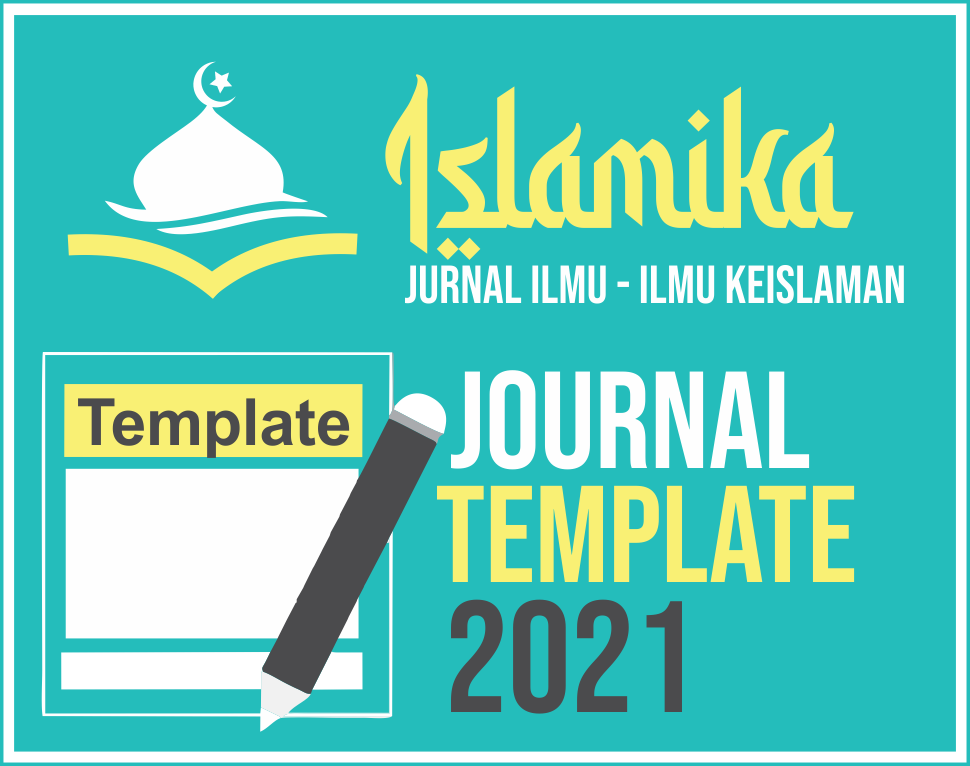Visualisasi Ayat Kursi pada Ornamen Kursi Mimbar (Studi Living Qur’an di Masjid Quwwatul Islam Yogyakarta)
DOI:
https://doi.org/10.32939/islamika.v25i1.4843Keywords:
Ornamen; Living Qur’an; Ayat Kursi.Abstract
This article discusses the visualization of the Ayat al-Kursi (Verse of the Throne) on the pulpit chair in the Quwwatul Islam Mosque in Yogyakarta. The ornamentation of Ayat al-Kursi in the form of a chair signifies that the Quran has entered the realm of aesthetic dimensions. The decorative carving of Ayat al-Kursi displayed by the author is a result of the reception of a fusion between Javanese and Kalimantanese artistry with the Quran. In this context, the author employs Alfred Schlutz's theory to elucidate two phenomena, namely the because motive and the in-order-to motive. The findings of this research are twofold. Firstly, the inclusion of Ayat al-Kursi as an ornament on the pulpit chair is because this verse possesses extraordinary meaning and content, explicating the magnificence of Allah over all of His creations. Secondly, it serves as a reminder to the preachers and congregants to always remember Allah SWT and His omnipotence, as well as to encourage the congregants to frequent the mosque for worship. Thus, the presence of the Ayat al-Kursi ornament on the chair not only signifies aesthetic values but also holds a profound history and encapsulates religious values found within the Quran.
Downloads
References
Abidin, Z. (2023, November 23). Wawancara [Komunikasi pribadi].
Abshor, M. U. (2019). TRADISI RESEPSI AL-QUR’AN DI MASYARAKAT GEMAWANG SINDUADI MLATI YOGYAKARTA: (Kajian Living Qur’an). QOF, 3(1), 41–54. https://doi.org/10.30762/qof.v3i1.1022
Ahliya, S., & Darta, A. (2024). Analisis Praktik Dan Pemahaman Masyarakat Terhadap Pembacaan Yasin 41 (Studi Living Quran Di Desa Besilam Kecamatan Padang Tualang Kabupaten Langkat). Kamaya: Jurnal Ilmu Agama, 7(2), Article 2. https://doi.org/10.37329/kamaya.v7i2.3400
Ahmad, Z. A. (2001). Membangun negara Islam (Cet. 1.). Pustaka Iqra.
Alashari, D. M., Hamzah, A. R., & Marni, N. (2019). Islamic art and language as a source of inspiration leading to traditional Arabic calligraphy art. UMRAN-International Journal of Islamic and Civilizational Studies, 6(3), 33–45.
Blair, S. S., & Bloom, J. M. (1996). The Art and Architecture of Islam, 1250–1800 (Reprint edition). Yale University Press.
Dian Permatasari, N. 11510065. (2015). KALIGRAFI DALAM ESTETIKA ISLAM MENURUT ISMA’IL RAJI AL-FARUQI [Skripsi, UIN SUNAN KALIJAGA]. https://digilib.uin-suka.ac.id/id/eprint/17363/
Esack, F. (2009). The Qur’an: A beginner’s guide. Oneworld.
Falah, A. M., Cahyana, A., & Yana, D. (2016). FUNGSI KALIGRAFI ARAB PADA MASJID-MASJID DI KOTA BANDUNG. ATRAT: Jurnal Seni Rupa, 4(3), Article 3. https://doi.org/10.26742/atrat.v4i3.368
Gill, S. D. (1999). Approaches to the Study of Religion. Method & Theory in the Study of Religion, 11(2), 119–126.
Hamdan, A. (2023, November 23). Wawancara [Komunikasi pribadi].
Ibbus, N. (2023, November 25). Wawancara [Komunikasi pribadi].
Ilhaq, M. (2017). BENTUK DAN PENEMPATAN ORNAMENPADA MESJID AGUNG PALEMBANG. Ekspresi Seni, 18(2). https://doi.org/10.26887/ekse.v18i2.91
Latifah, I. S., & Darmawan, C. (2021). Penerapan Ornamen Motif Kaligrafi Khuffi Pada Masjid Jami Al-Irsyad. DIVAGATRA - Jurnal Penelitian Mahasiswa Desain, 1(1), Article 1. https://doi.org/10.34010/divagatra.v1i1.4870
Mahtubah, H. (2020). Resepsi Masyarakat Madura Terhadap QS. AL-Ikhlas dalam Tradisi Kompolan Sabellesen. Nun: Jurnal Studi Alquran Dan Tafsir Di Nusantara, 6(2), Article 2. https://doi.org/10.32495/nun.v6i2.164
Ma’ruf, A. (2023, November 23). Wawancara [Meeting].
Nafroni, I. (2022, November 19). Wawancara [Komunikasi pribadi].
Nindito, S. (2005). Fenomenologi Alfred Schutz: Studi tentang konstruksi makna dan realitas dalam ilmu sosial. Jurnal ilmu komunikasi, 2(1).
Rafiq, A. (2014). The Reception of the Qur’an in Indonesia: A Case Study of the Place of the Qur’an in a Non-Arabic Speaking Community [Ph.D., Temple University]. Dalam ProQuest Dissertations and Theses. https://www.proquest.com/docview/1617432300/abstract/AC55AD45AE34BF3PQ/1
Rafiq, A. (2021). The Living Qur’an: Its Text and Practice in the Function of the Scripture. Jurnal Studi Ilmu-Ilmu Al-Qur’an Dan Hadis, 22(2), Article 2. https://doi.org/10.14421/qh.2021.2202-10
Sarif, D. (2016). PENGARUH ALQURAN TERHADAP PERKEMBANGAN KALIGRAFI ARAB. ETNOHISTORI: Jurnal Ilmiah Kebudayaan dan Kesejarahan, 3(2), Article 2. https://doi.org/10.33387/jeh.v3i2.848
Schutz, A. (1970). Alfred Schutz on Phenomenology and Social Relations. University of Chicago Press.
Schutz, A. (with Breda, H. L. van). (1982). Collected papers. I. The problem of social reality (M. Natanson, Ed.). Martinus Nijhoff.
Setiadi, Y. (2019). Kaligrafi al-Qur’an Sebagai Ornamen Masjid (Studi Living Qur’an di Masjid Nurulimam). HERMENEUTIK, 13(2), 165–189. https://doi.org/10.21043/hermeneutik.v13i2.6404
Sirojuddin, A. R. (2014). Peta Perkembangan Kaligrafi Islam di Indonesia. Al-Turas, 20(1), 219–232.
Soraya, S. (2012). Nilai dan Makna Kaligrafi Arab pada Masjid Al-Atiq (Analisis Estetik). Students e-Journal, 1(1), Article 1.
‘Ula, N. H., & Prasetia, S. A. (2020). PERFORMATIVE ANALYSIS OF RAJAH SYEKH SUBAKIR IN TAWING VILLAGE, TRENGGALEK PERSPECTIVE OF LIVING QUR’AN. Jurnal Studi Ilmu-ilmu Al-Qur’an dan Hadis, 21(2), 313. https://doi.org/10.14421/qh.2020.2102-04
Zulihafnani, Z., Nurlaila, N., & Hidayatullah, M. R. (2020). PENGGUNAAN PAJANGAN AYAT KURSI SEBAGAI PELINDUNG. TAFSE: Journal of Qur’anic Studies, 5(2), 139. https://doi.org/10.22373/tafse.v5i2.9103
Downloads
Published
How to Cite
Issue
Section
License
Copyright (c) 2025 Moh. Abdulloh Hilmi, M. Muflih, Faisal Diaulhaq

This work is licensed under a Creative Commons Attribution-ShareAlike 4.0 International License.









